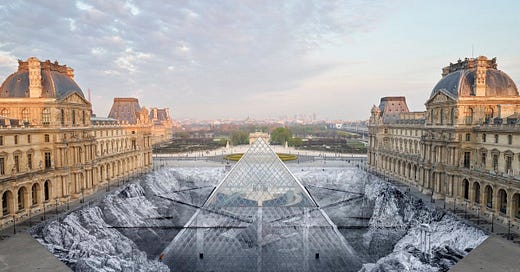From Canvas to LED Screens: Anamorphosis
How this old visual effect still leaves the viewer stunned
Anamorphic illusions are a fascinating and creative form of art that plays with perspective to create a distorted image that appears normal when viewed from a specific angle or through a certain device. This technique has its origins in the Renaissance period and was used to create hidden or surprising elements in artworks.
How does it work?
An anamorphic illusion typically involves a highly distorted image or object that seems almost unrecognizable at first glance. However, when viewed from a particular angle or through a special lens or mirror, the true image suddenly snaps into focus, revealing a clear and often surprising picture. This effect exploits the way our eyes and brain interpret visual information, bending the rules of perspective and dimensions.
In modern times, anamorphic illusions have found a new canvas in large format LED screens. For example, locations like Piccadilly Circus or Outernet London showcase enormous digital displays that use anamorphic visuals to create stunning, three-dimensional-looking images that seem to pop out of the screen or dive into it, creating a deep, immersive experience for viewers. These illusions are created using advanced computer graphics and careful planning to ensure the effect is visible from specific viewpoints, making them a blend of art and technology.
Anamorphic illusion is not new
The concept of anamorphic art dates back to the Renaissance, when artists began experimenting with perspective to create hidden or transformative images. One of the earliest known examples is the anamorphic skull in Hans Holbein's painting "The Ambassadors" (1533), which appears as a strange streak at the bottom of the painting but reveals itself as a skull when viewed from an acute angle.
This technique was initially used for secretive or playful purposes, allowing artists to embed hidden messages or images in their works. Over time, it evolved into a distinct art form, with artists exploring its potential to create striking visual illusions.
Do you want to give it a go?
Here's a simple exercise for creating an anamorphic illusion using the casted shadow of an object:
Choose an Object: Select a simple object like a cup or a toy.
Lighting: Place the object on a sheet of paper and use a direct light source to cast a distinct shadow on the paper. You can use the mobile torch, for example.
Outline the Shadow: Carefully draw the outline of the shadow with a pencil. Make sure to capture all the details of the distorted shadow.
Remove the Object: Remove the object and examine the outline. It will look distorted and may not immediately resemble the object.
Find the Right Viewpoint: Move around the paper until you find an angle where the outline looks like the actual object. This is the 'magic' viewpoint where the anamorphic illusion comes to life.
Ta-da! your first anamorphic illusion!










